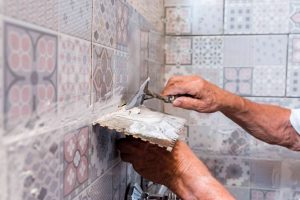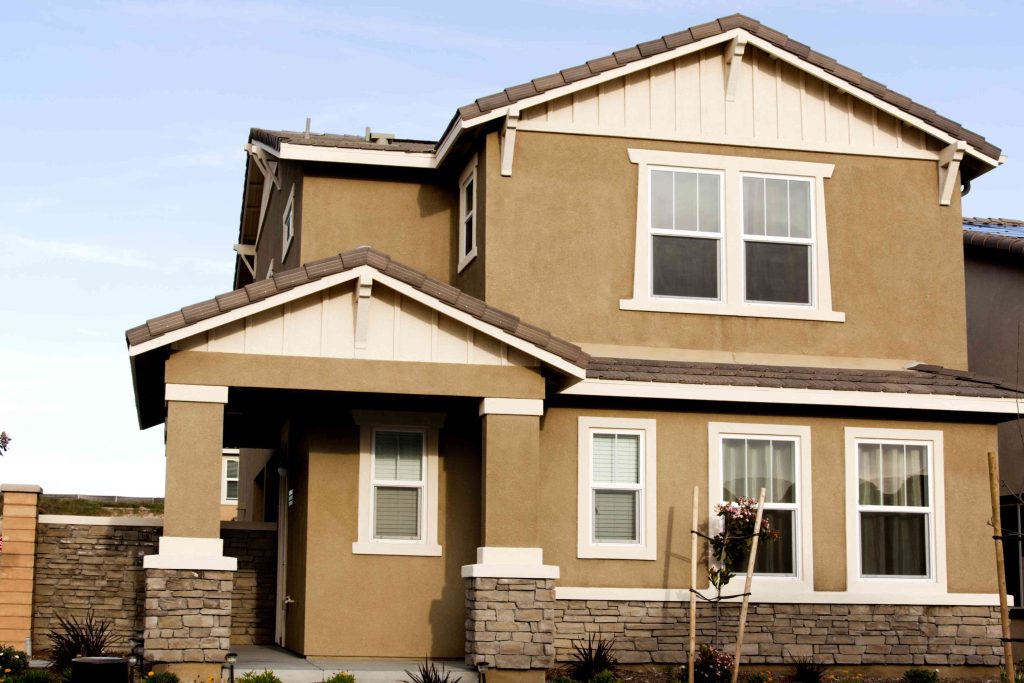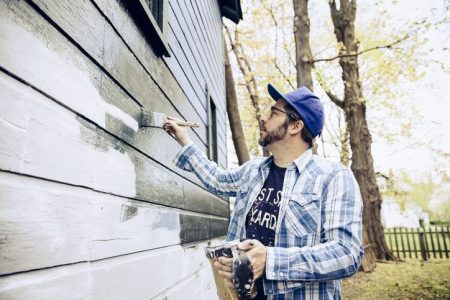Stucco is an eco-friendly building material that typically consists of limestone, concrete, and sand. It’s a popular choice as an exterior building material for the walls of the home, or even for a back garden wall, and it has a unique texture that makes it stand out from vinyl siding and brick. However, the porous composition and the uneven texture contribute to dirt, mold, and mildew accumulation on the stucco surface, which is why it’s important to regularly sanitize and clean stucco.
Working With a Pressure Washer
A pressure washer is a great tool to help clean stucco surfaces, but it’s important to understand that the texture and construction of stucco make it vulnerable to very high water pressure. In order to clean the stucco without damaging it, only use the pressure washer on the lowest setting and ensure that it’s equipped with a low-pressure spray tip nozzle. Also, it’s advised to hit the wall at a 45-degree angle while keeping the pressure washer at least two feet away from the stucco surface.
If you are concerned that your pressure washer will damage the stucco surface, you could use a hose and spray nozzle instead. The spray may not penetrate as deeply into the stucco, but this method won’t damage the surface.
How Often to Clean Stucco
Due to the texture of stucco and its porosity, dirt, mold, and mildew can quickly accumulate, which is why these surfaces need to be cleaned regularly in order to keep the home looking great. Ideally, stucco surfaces should be cleaned two to three times per year, however, once a year is acceptable for most homes.
What You’ll Need
Equipment / Tools
- Hose
- Pressure washer
- Low pressure spray tip nozzle
- Caulking gun
- Spray bottle
- Safety goggles
- Protective gloves
- Respiratory protection mask
- Soft bristle brush
- Bucket
Materials
- Exterior acrylic caulk
- Bleach
- Concentrated exterior cleaner
- Borax
- Dish soap
Instructions
How to Clean Stucco
-
Inspect and Repair the Stucco Surface
Before you can clean the stucco, it’s necessary to inspect the surface for any chips, cracks, or breaks because if water gets into these spaces, it can lead to mold and mildew forming inside the walls. Small cracks and chips can be repaired with exterior acrylic caulking that seals the porous interior against water. However, large cracks, crevices, and other damage should be repaired by a professional.
During your inspection, look for any signs of mold, mildew, or algae growth to focus on while cleaning the stucco. Mold and mildew can create a black stain on stucco, while algae stains the stucco green. These growths need to be treated with bleach or borax to properly eliminate them and prevent further growth.
-
Prepare a Cleaning Solution
There are several different cleaning solutions that are effective at cleaning dirt and grime from stucco surfaces. The best option is to invest in a concentrated exterior cleaner that is specifically made for cleaning the outside of the home. These solutions typically clean and disinfect, though some products may need to be mixed with water and bleach in order to properly eliminate growths like mold, mildew, and algae. Always follow the manufacturer’s directions for properly mixing concentrated exterior cleaner.
A mixture of one cup of liquid bleach and one gallon of water is also good for removing mold, mildew, and algae stains, though it isn’t as effective against dirt and grime. If you prefer not to use bleach, borax and dish soap is another alternative. borax is less harsh than bleach but still effective. Just mix 1/2 cup of borax, two tablespoons of dish soap, and two gallons of hot water.
Pour the selected solution into a spray bottle so that it’s ready to use on the stucco surface.
Warning
Mixing certain types of cleaning chemicals can create hazardous conditions. Always carefully follow manufacturers’ mixing guidelines for the cleaning product you are using, and if you’re uncertain, use a different method.
-
Spray the Stucco
Using a power washer or a garden hose with a spray nozzle, spray the stucco so that it is completely saturated. If you choose to use a power washer, just make sure that it is set to the lowest water pressure setting and that the pressure washer is equipped with a low-pressure spray tip nozzle. This step is just to wet the wall, so excess pressure is unnecessary. Also, ensure that the pressure washer is angled at 45 degrees and held at least two feet from the stucco surface to avoid causing damage.
-
Apply Cleaning Solution
The cleaning solution that was prepared before spraying the stucco should be ready to go in a spray bottle. Start with one section of the wall and spray it with the solution, ensuring that the cleaner is evenly spread over the entire area. Allow the cleaning solution to sit on the stucco for at least 10 minutes before proceeding. Some severely stained areas of the stucco surface may need to have the cleaning solution applied for up to 30 minutes while the stains are scrubbed clean.
-
Scrub Difficult Stains
Some areas of the stucco may have stubborn stains that cannot be removed by simply soaking the area in a cleaning solution and rinsing it with a power washer. In these instances, it’s necessary to use a soft bristle brush to scrub the stucco clean without damaging the material. Fill a bucket with your cleaning solution of choice and dip the bristles of the brush into the bucket in order to apply the chemical cleaner while you physically scrub the surface with the soft bristle brush. Just make sure that you don’t scrub too hard because the bristles can smooth down the texture of the stucco with enough force.
For a less physically taxing method, consider investing in a powered rotating scrub brush to tackle these difficult stains.
-
Rinse the Stucco Surface
After the cleaning solution has had time to loosen the dirt, grime, mold, mildew, and other debris, you can use the hose or power washer to begin rinsing the cleaner off of the stucco. As mentioned previously, take care to only use the pressure washer on the lowest setting in order to avoid damaging the stucco with a blast of high-pressure water.
Start at the top of the stucco surfaces and slowly move down, ensuring that the pressure washer or hose hits every part of the wall. The cleaning solution, as well as a significant amount of dirt and grime, should begin falling down the stucco as the water rinses the surface. Move the spray of water back and forth horizontally until the entire surface has been properly rinsed.
The stucco surface will usually take about 24 hours to properly dry after it has been washed, so it’s best to choose a day with no wind or rain in order to keep the stucco as clean as possible while it dries.
Tips to Keep Your Stucco Clean Longer
- Prevent any staining and discoloration along the bottom of the walls by putting rock, mulch, etc to cover the dirt around the home.
- As soon as you see any hairline cracks forming, clean that area, let it dry, and fix it with caulk.
- Regular cleaning will help keep painted stucco from fading and discoloring.
When to Call a Professional
If you see large cracks in the stucco, or other damage you’re questioning, you should call a professional for them to assess if it’s because of the house’s foundation settling or shifting.
Read the full article here














